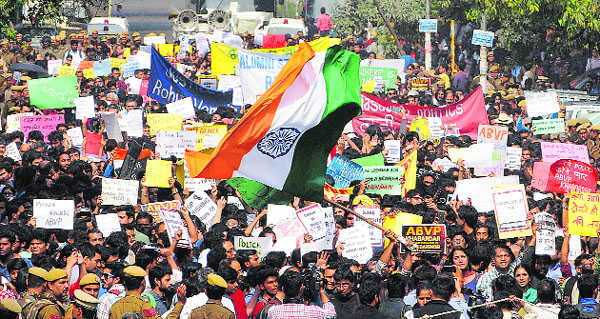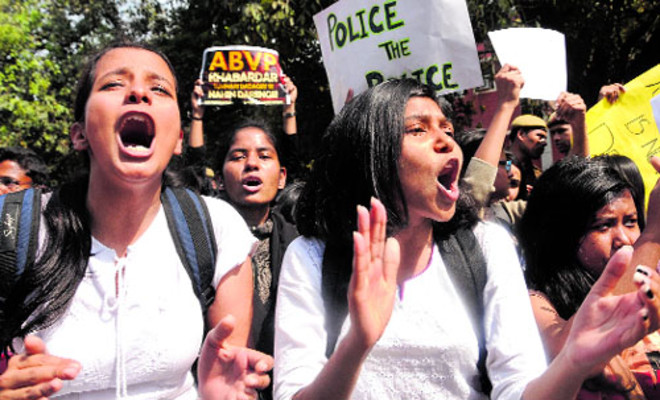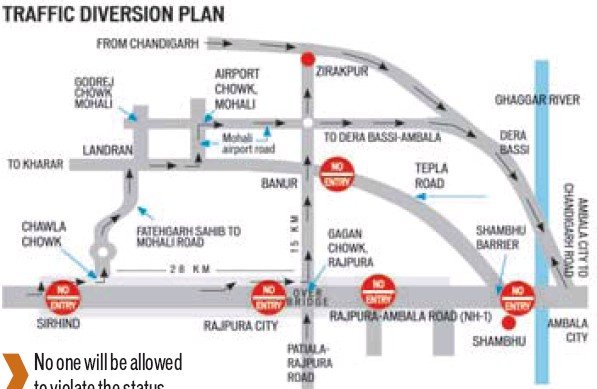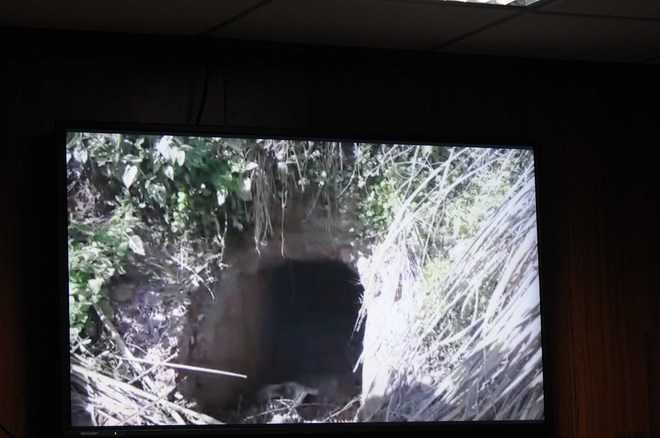As tweet by daughter of officer killed in 1999 sets social media ablaze, politicians jump in with opposed narratives of subversion and freedom of expression
NEW DELHI: The daughter of an army martyr polarised political and public opinion on patriotism and free speech on Monday, after getting rape threats for posting her protest against the rightwing ABVP over the Capital’s latest campus unrest.
 BURHAAN KINU/HTABVP members march with a 180footlong Tricolour in DU’s North Campus on Monday.
BURHAAN KINU/HTABVP members march with a 180footlong Tricolour in DU’s North Campus on Monday.
The controversy began after 20-year-old Gurmehar Kaur, a Delhi University student, posted a picture of herself on Twitter and Facebook. She was seen holding a placard that broadcast her views on last week’s violent clashes in DU where ABVP members allegedly assaulted students, teachers and journalists during a protest march.
“I am student from Delhi University. I am not afraid of ABVP. I am not alone. Every student of India is with me,” the message read. The post went viral on Sunday. She was trolled, called an anti-national, and allegedly threatened with rape for her campaign against the ABVP, which owes allegiance to the RSS, the BJP’s ideological mentor. Politicians jumped into the debate soon enough, with junior home minister Kiren Rijiju asking in a tweet: “Who’s polluting this young girl’s mind? A strong Arm Force prevents a war. India never attacked anyone but a weak India was always invaded.”
Rijiju, the BJP parliamentarian from Arunachal Pradesh, was referring to an old picture of the Lady Shri Ram College literature student that resurfaced on social media. The placard in this photo reads: “Pakistan did not kill my dad, war did.”
Kaur’s father Captain Mandeep Singh was killed in Kashmir soon after Kargil war in 1999. Her social media campaign reignited the debate over intolerance as celebrities such as former cricketer Virender Sehwag and Bollywood actor Randeep Hooda criticising her remarks. The actor even called her a political pawn. Kaur retorted: “Really sweet of you to encourage the hate I’ve been receiving. Makes me feel happy that I adored your work 🙂 Pawn? I can think. I don’t support violence perpetuated on students? Is that so wrong (sic).”
She responded individually to Rijiju and Sehwag too, saying she was not anti-national and her mind is not polluted. The student said she was hurt that the cricketer she had cheered for so often trolled her “at the cost of her father’s death”. CHANDIGARH: Gulgul. That’s what late Capt Mandeep Singh used to call his elder daughter Gurmehar. He wrote her name on a pile of snow in Kupwara in the Kashmir valley, and clicked a picture for his two-year-old daughter back home. It’s a picture that Gurmehar Kaur, 20, carries with her like a talisman 18 years after his death in the Valley.
Today, the first-year English honours student of Lady Shri Ram College in Delhi has become the subject of a vicious war of words being waged on the social media. All over a Facebook post in which she slammed the Akhil Bharatiya Vidyarthi Parishad (ABVP) action at Ramjas College.
Capt Mandeep’s brother Davinderdeep Singh, a professor of English at DAV College, Nakodar, says his brother would have stood like a rock behind his daughter. “He would have supported her tooth and nail. She is entitled to her opinion, she did not say anything anti-national.”
ON CAPT MANDEEP
Capt Mandeep, 30, was posted in 4 Rashtriya Rifles (RR) in Kupwara when militants stormed his camp in August 1999. He was killed in the gunbattle that followed. Davinderdeep, who was 24 at that time, says a few months earlier, his brother had shot down three militants in a 30-hour encounter at Bandipora.
“He was much dreaded by militants active in the area. They had kept a reward on him. Even when they stormed the camp, they shouted out his name,” he recounts.
Capt Mandeep was an avid bodybuilder . Anup Vats, a former professor at DAV College, Jalandhar, recalled how Mandeep had taken part in Mr Jalandhar contest.
VOICE OF RAM
Gurmehar, all of two when Capt Mandeep was killed, and her younger sister Bani, who was only five months old, remember a lifetime spent missing their father.
Gurmehar first shot into limelight in May last year, when she was the subject of a silent video by Ram Subramaniam, an ad filmmaker whose Facebook page, “Voice Of Ram”, aims to “create a positive change”. Telling her story through placards, Gurmehar recounted how she had tried to stab a burqa-clad woman when she was six because she believed Muslims had killed her father.
She had a change of heart when her mother, Rajvinder Kaur, a Punjab Civil Services officer, taught her that it was a war that killed her father, not people from a particular religion. “Today, I am also a soldier just like my dad. I fight for peace between India and Pakistan.”
BOOK ON INDO-PAK PEACE
In a Facebook live chat on January 30 this year, Gurmehar says: “My life has been very difficult. But my mother taught me that hate doesn’t get you anywhere .”
Praising her college, she says it encouraged open thoughts and free conversations. Saying that she was working on Indo-Pak peace, Gurmehar disclosed that she had penned a book on life in the forces and peace between the two neighbours. “We can have a cordial relationship.”
Gurmehar, who commands quite a following in Pakistan, says that she wants to visit Pakistan, hopefully this year.


Davinderdeep says the family is traumatised by the vicious attacks on Gurmehar, calling her anti-national. “We haven’t said a word about this to my father who is very ill.”
A soldier’s daughter, she fights for Indo-Pak peace
HANDIGARH: Gulgul. That’s what late Capt Mandeep Singh used to call his elder daughter Gurmehar. He wrote her name on a pile of snow in Kupwara in the Kashmir valley, and clicked a picture for his two-year-old daughter back home. It’s a picture that Gurmehar Kaur, 20, carries with her like a talisman 18 years after his death in the Valley.
Today, the first-year English honours student of Lady Shri Ram College in Delhi has become the subject of a vicious war of words being waged on the social media. All over a Facebook post in which she slammed the Akhil Bharatiya Vidyarthi Parishad (ABVP) action at Ramjas College.
Capt Mandeep’s brother Davinderdeep Singh, a professor of English at DAV College, Nakodar, says his brother would have stood like a rock behind his daughter. “He would have supported her tooth and nail. She is entitled to her opinion, she did not say anything anti-national.”
ON CAPT MANDEEP
Capt Mandeep, 30, was posted in 4 Rashtriya Rifles (RR) in Kupwara when militants stormed his camp in August 1999. He was killed in the gunbattle that followed. Davinderdeep, who was 24 at that time, says a few months earlier, his brother had shot down three militants in a 30-hour encounter at Bandipora.
“He was much dreaded by militants active in the area. They had kept a reward on him. Even when they stormed the camp, they shouted out his name,” he recounts.
Capt Mandeep was an avid bodybuilder . Anup Vats, a former professor at DAV College, Jalandhar, recalled how Mandeep had taken part in Mr Jalandhar contest.
VOICE OF RAM
Gurmehar, all of two when Capt Mandeep was killed, and her younger sister Bani, who was only five months old, remember a lifetime spent missing their father.
Gurmehar first shot into limelight in May last year, when she was the subject of a silent video by Ram Subramaniam, an ad filmmaker whose Facebook page, “Voice Of Ram”, aims to “create a positive change”. Telling her story through placards, Gurmehar recounted how she had tried to stab a burqa-clad woman when she was six because she believed Muslims had killed her father.
She had a change of heart when her mother, Rajvinder Kaur, a Punjab Civil Services officer, taught her that it was a war that killed her father, not people from a particular religion. “Today, I am also a soldier just like my dad. I fight for peace between India and Pakistan.”
BOOK ON INDO-PAK PEACE
In a Facebook live chat on January 30 this year, Gurmehar says: “My life has been very difficult. But my mother taught me that hate doesn’t get you anywhere .”
Praising her college, she says it encouraged open thoughts and free conversations. Saying that she was working on Indo-Pak peace, Gurmehar disclosed that she had penned a book on life in the forces and peace between the two neighbours. “We can have a cordial relationship.”
Gurmehar, who commands quite a following in Pakistan, says that she wants to visit Pakistan, hopefully this year.


Davinderdeep says the family is traumatised by the vicious attacks on Gurmehar, calling her anti-national. “We haven’t said a word about this to my father who is very ill.”



 BURHAAN KINU/HT
BURHAAN KINU/HT





































































